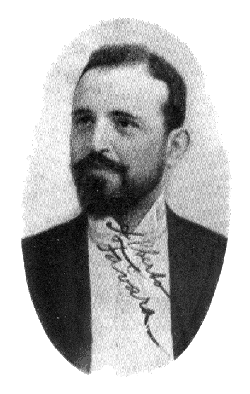
|
Alberto Favara
|
Alberto Favara Mistretta was born in Salemi (TP) on 1 June 1863. First was a pupil of the teacher Fodale Conservatory of Music in Palermo and later the teacher A. Scontrino to Milan, but it was applied tenaciously to the studies also from self-taught. He deepened his knowledge in all directions, and was especially attracted by the history of music, not as narratives of musical life, but as a critical assessment of studies and works. From this base later began his interest in folk music. In the technical field interested him the acoustics for that connection it has with music, with sound phenomenon and the construction and performance of musical instruments. The rhythmic and metric helped him to investigate the intimate organization of device sounds and their formal structure, from simple to more
|

|
complex creations. In 1897 became professor of composition at the Conservatory of Music in Palermo was not content to lead the teaching practices of the time according to the monotonous. Convinced that the survey was the proto most promising method to point out to young people with the most hidden similarities, especially the history of music was, by Alberto Favara, life impulse. Remained for two years head of the Institute, gave him the tools required to work. And these were not only musical instruments new, improved, commissioned the best factories in Europe, but were also books, books of musical culture. Like all innovators had some criticism from the experts of the Music Conservatory of Palermo. They clung to their customs and the new course was not easy to digest. The most important dates from the artistic point of view these are soon:
- 1884, execution of his work Marcellina, winning the contest Sonzogno at the Dal Verme in Milan.
- 1904, implemented the R. Academy St. Cecilia ode to the Queen of Italy for soloists, chorus and orchestra.
- 1918, esecuzione di un'altra sua opera, Urania, alla Scala di Milano.
- 1907 and 1921, publication of the first and second volume of the Songs of the land and sea of Sicily.
In 1898 he published his comprehensive review on the popular song into art, where already, albeit timidly, he became interested in a problem that will take him, a pilgrim of love, from country to country, to collect folk melodies of his homeland. Another important date in his biography was the 1903: the year in which he read a very interesting communication to the third Italian Congress of Historical Sciences, where he drew the attention of historians on popular music that folklorists they liked ... but in reality, remains a land of mission, a remote island to explore... Nor, finally, we must not forget his two essays published in 1923, shortly before his death at Palermo in the same year, where he quickly traced the history of Sicilian music of popular songs, while at the same time, as if to draw a perfect his will, never failed to be assigned to the mission of driving folk music to the same scholarly. Posthumously, edited by Ottavio Tiby, were published two volumes of the Corpus of Sicilian folk music, containing 1090 songs or melodies such disparate collected from the voice or the instruments of the common people who were delighted and delight their countrymen.
|
|

|
|

